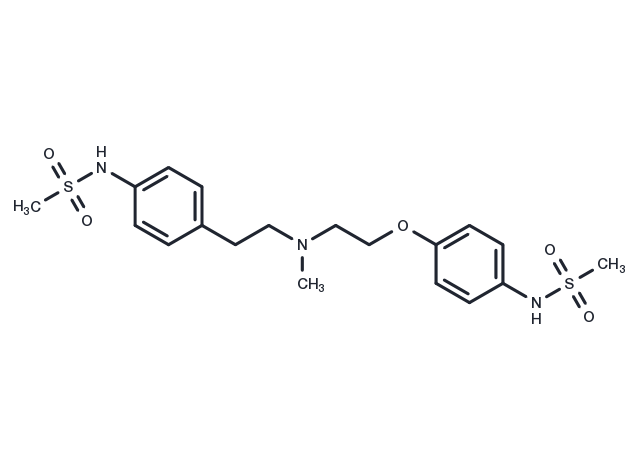Powder: -20°C for 3 years | In solvent: -80°C for 1 year


Dofetilide (UK 68789) is a sulfonamide class III antiarrhythmic agent and potassium channel blocker. Dofetilide selectively blocks cardiac ion channels of the rapid component of the delayed rectifier potassium current Ikr. This antiarrhythmic agent prolongs cardiac action potential duration and effective refractory period due to delayed repolarization without affecting conduction velocity. This results in a normal sinus rhythm. Dofetilide is used in the treatment of atrial fibrillation and flutter.

| Pack Size | Availability | Price/USD | Quantity |
|---|---|---|---|
| 5 mg | In stock | $ 50.00 | |
| 10 mg | In stock | $ 63.00 | |
| 25 mg | In stock | $ 119.00 | |
| 50 mg | In stock | $ 187.00 | |
| 100 mg | In stock | $ 263.00 | |
| 200 mg | In stock | $ 506.00 | |
| 500 mg | In stock | $ 823.00 | |
| 1 mL * 10 mM (in DMSO) | In stock | $ 50.00 |




| Description | Dofetilide (UK 68789) is a sulfonamide class III antiarrhythmic agent and potassium channel blocker. Dofetilide selectively blocks cardiac ion channels of the rapid component of the delayed rectifier potassium current Ikr. This antiarrhythmic agent prolongs cardiac action potential duration and effective refractory period due to delayed repolarization without affecting conduction velocity. This results in a normal sinus rhythm. Dofetilide is used in the treatment of atrial fibrillation and flutter. |
| In vitro | Dofetilide blocks HERG currents in excised macro patches of Xenopus oocytes. [1] Dofetilide (1 μM) reduces the amplitude of IKr to 61% of control currents in guinea pig cardiomyocytes, as measured by 200-ms test pulses and analysis of the deactivating tail currents of IKr. [2] Dofetilide increases apico-basal disparity of repolarization, due to a more marked increase of ERPs in the apex than in the base in the intact canine heart. [3] |
| In vivo | Dofetilide (100 mg/kg, i.v.) does not suppress automaticity arrhythmias induced by two-stage coronary ligation and epinephrine or the coronary ligation and reperfusion arrhythmias, but suppresses the reentry arrhythmia induced by PES in dogs with old myocardial infarction (MI). Dofetilide also shows antiarrhythmic effect in some dogs with digitalis arrhythmia. Dofetilide increases QT interval and shows negative chronotropic effect like that of other class III drugs, but is different in antiarrhythmic profiles from those of other class III agents such as D-sotalol, E-4031, and MS-551 in that it does not prevent the occurrence of ventricular fibrillation (VF) immediately after coronary reperfusion and has some antiarrhythmic effects on digitalis arrhythmia. [4] Dofetilide causes increased resorptions and the same stage-dependent malformations in Sprague-Dawley rats. [5] |
| Synonyms | UK 68789, UK-68798, Tikosyn |
| Molecular Weight | 441.56 |
| Formula | C19H27N3O5S2 |
| CAS No. | 115256-11-6 |
Powder: -20°C for 3 years | In solvent: -80°C for 1 year
DMSO: 44.2 mg/mL (100 mM)
You can also refer to dose conversion for different animals. More
bottom
Please see Inhibitor Handling Instructions for more frequently ask questions. Topics include: how to prepare stock solutions, how to store products, and cautions on cell-based assays & animal experiments, etc.
Dofetilide 115256-11-6 Membrane transporter/Ion channel Potassium Channel cardiovascular UK68798 UK68789 potent specific class antiarrhythmic UK 68789 UK-68798 orally UK-68789 Inhibitor Tikosyn inhibit KcsA UK 68798 III agent inhibitor
